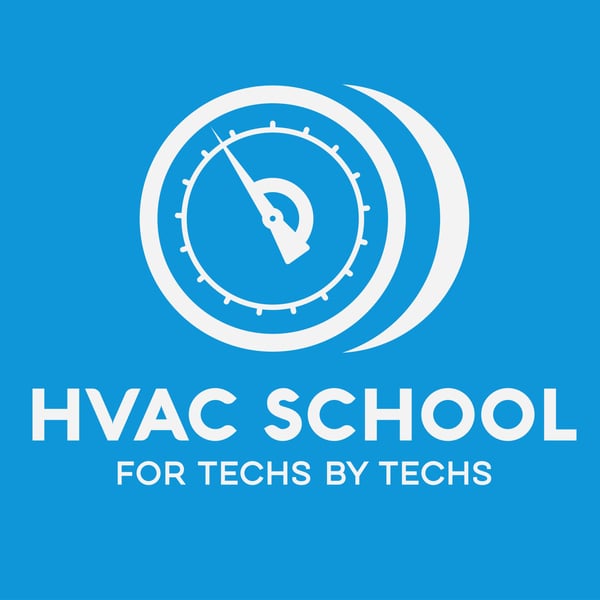Heat Exchangers and Temperature Rise - Short #227
HVAC School - For Techs, By Techs
Bryan Orr
4.8 • 985 Ratings
🗓️ 21 January 2025
⏱️ 9 minutes
🧾️ Download transcript
Summary
In this short podcast episode, Bryan talks about heat exchangers and temperature rise in gas furnaces, especially 80% open-combustion gas furnaces.
Temperature rise is the difference between the return air temperature and supply air temperature; in cooling, we usually refer to this difference as a delta T or temperature split. The manufacturer sets a target range on the data plate; high-efficiency furnaces tend to have lower temperature rise targets than mid-efficiency or older furnaces. We want to heat the space and not waste heat on surfaces (like duct surfaces). For that reason, the goal is to stay in the middle of the temperature rise range or slightly on the lower side for peak efficiency, better heat transfer, proper airflow, proper venting, and protection of the heat exchanger.
In mid-efficiency furnaces, we don't want the temperature rise to be too low, as cooler gases can condense. High-efficiency condensing furnaces have a dedicated condensate system, but 80% furnaces do not. That condensation can corrode the heat exchanger, which makes it vulnerable to cracks. Cracked heat exchangers may also happen when the temperature rise is too high, and they are dangerous due to carbon monoxide (CO) leaks; check for abnormal flame movement and color. Lower-temperature air is also uncomfortable if the registers are in locations where blowing air on people is inevitable.
We can reduce the temperature rise by increasing the heating airflow, which can sometimes be done by re-tapping constant-torque and PSC motors or changing ECM settings. However, restrictive filters and ductwork may also cause that problem, and they need to be addressed.
Have a question that you want us to answer on the podcast? Submit your questions at https://www.speakpipe.com/hvacschool.
Purchase your tickets or learn more about the 6th Annual HVACR Training Symposium at https://hvacrschool.com/symposium.
Take the HVAC School Industry Pulse Survey by WorkHero at https://hvacrschool.com/industrypulse.
Subscribe to our podcast on your iPhone or Android.
Subscribe to our YouTube channel.
Check out our handy calculators here or on the HVAC School Mobile App for Apple and Android
Transcript
Click on a timestamp to play from that location
| 0:00.0 | HVAC School. This is the HVAC School podcast. I'm Brian. This is the podcast that helps you remember some things. |
| 0:11.0 | You might have forgotten along the way as well as helps you remember some things you forgot to know in the first place. |
| 0:15.0 | And it is heating season. We are in the season of heating. And though I am in central Florida, I actually have worked on a good |
| 0:22.8 | amount of gas furnaces. Now, the gas furnaces that I've worked on are 80% open combustion, |
| 0:30.0 | non-condensing type furnaces. I don't have the experiences some of you all have, but there is one |
| 0:35.8 | thing that I do have experience with, and that is measuring temperature rise, which is what we're going to talk about today on the |
| 0:40.9 | podcast, heat exchangers and temperature rise. But before we do that, we want to thank our great |
| 0:45.5 | sponsors. |
| 0:46.3 | Refrigeration Technologies at refrigetech.com, and specifically the new Viper Wetrag Heat Shield, |
| 0:53.3 | the revolutionary flame-resistant welding pad |
| 0:55.8 | designed to be used either wet or dry. Find a Viper wet-rag heat shield at a distributor near you |
| 1:02.5 | or go to TrueTechTools.com and use offer code, get schooled for a great discount at checkout. |
| 1:09.1 | Carrier and Carrier.com? |
| 1:11.8 | Fieldpiece. |
| 1:13.7 | Fieldpiece.com. |
| 1:20.4 | ESCO Group's HVACR Learning Network has a brand new course bundle about high-performance heat pumps. |
| 1:25.1 | Heat pumps are becoming a lot more popular, especially in cold climates, and this new course bundle will get you up to speed on designing and servicing variable speed heat pumps. |
| 1:30.1 | It starts with the basics of heat pumps for people who have worked on furnaces their entire lives. |
| 1:34.6 | Not like me. I'm a heat pump guy through and through. |
| 1:37.3 | But for those of you who are new to it, it covers the basic principles and startup practices, |
| 1:41.7 | covers design considerations. |
| 1:43.5 | For those of you who are interested in advanced |
... |
Please login to see the full transcript.
Disclaimer: The podcast and artwork embedded on this page are from Bryan Orr, and are the property of its owner and not affiliated with or endorsed by Tapesearch.
Generated transcripts are the property of Bryan Orr and are distributed freely under the Fair Use doctrine. Transcripts generated by Tapesearch are not guaranteed to be accurate.
Copyright © Tapesearch 2025.

